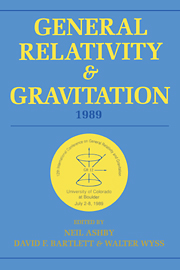 General Relativity and Gravitation, 1989
General Relativity and Gravitation, 1989 Book contents
- Frontmatter
- Contents
- Preface
- Conference committees
- Part A Classical relativity and gravitation theory
- WORKSHOPS
- A1 Exact solutions and exact properties of Einstein equations
- A2 Spinors, twistors, and complex methods
- A3 Alternative gravity theories
- A4 Asymptotia, singularities, and global structure
- A5 Radiative spacetimes and approximation methods
- A6 Algebraic computing
- A7 Numerical relativity
- Part B Relativistic astrophysics, early universe, and classical cosmology
- WORKSHOPS
- Part C Experimental gravitation and gravitational wave detection
- WORKSHOPS
- Part D Quantum gravity, superstrings, quantum cosmology
- WORKSHOPS
- Part E Overviews-past, present, and future
A5 - Radiative spacetimes and approximation methods
Published online by Cambridge University Press: 05 March 2012
- Frontmatter
- Contents
- Preface
- Conference committees
- Part A Classical relativity and gravitation theory
- WORKSHOPS
- A1 Exact solutions and exact properties of Einstein equations
- A2 Spinors, twistors, and complex methods
- A3 Alternative gravity theories
- A4 Asymptotia, singularities, and global structure
- A5 Radiative spacetimes and approximation methods
- A6 Algebraic computing
- A7 Numerical relativity
- Part B Relativistic astrophysics, early universe, and classical cosmology
- WORKSHOPS
- Part C Experimental gravitation and gravitational wave detection
- WORKSHOPS
- Part D Quantum gravity, superstrings, quantum cosmology
- WORKSHOPS
- Part E Overviews-past, present, and future
Summary
Introduction
The workshop consisted of an introductory overview and of seven specialized talks. The talks were selected among twenty-five submitted abstracts and were presented in an order consistent with the three subsequently discussed categories, i.e. from rigourous mathematical results about approximation methods, to definition of approximation methods, to physical results obtained by approximation methods. This order was chosen to emphasize the following easily forgotten fact. Ideally, physics should connect the mathematical axioms defining our theories to the results of observations or experiments by means of a tight chain of deductions. However, in practice, this chain of deductions often contains gaps, and one of the main sources of gaps lies in the use of mathematically ill justified approximation methods as substitutes for the exact theories. In order to bridge the latter gap one needs, on the one hand, some clear algorithmic definition of the approximation methods used together with a formal study of the structure of its successive terms, and, on the other hand, mathematical theorems proving that the formal sequence defined by the ‘approximation method’ is either convergent, or asymptotic, to some exact solution. Progress on both aspects has recently been obtained, and has been reported, or quoted, during the workshop.
Talks presented at the workshop fell into three categories. Talks on mathematical results about approximation methods showed instances where the conceptually important gap between mathematics and the use of approximation methods by physicists can be closed, or narrowed.
- Type
- Chapter
- Information
- General Relativity and Gravitation, 1989Proceedings of the 12th International Conference on General Relativity and Gravitation, pp. 107 - 112Publisher: Cambridge University PressPrint publication year: 1990
